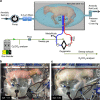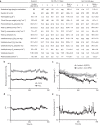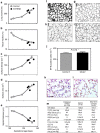An extra-uterine system to physiologically support the extreme premature lamb
- PMID: 28440792
- PMCID: PMC5414058
- DOI: 10.1038/ncomms15112
An extra-uterine system to physiologically support the extreme premature lamb
Erratum in
-
Corrigendum: An extra-uterine system to physiologically support the extreme premature lamb.Nat Commun. 2017 May 23;8:15794. doi: 10.1038/ncomms15794. Nat Commun. 2017. PMID: 28534492 Free PMC article.
Abstract
In the developed world, extreme prematurity is the leading cause of neonatal mortality and morbidity due to a combination of organ immaturity and iatrogenic injury. Until now, efforts to extend gestation using extracorporeal systems have achieved limited success. Here we report the development of a system that incorporates a pumpless oxygenator circuit connected to the fetus of a lamb via an umbilical cord interface that is maintained within a closed 'amniotic fluid' circuit that closely reproduces the environment of the womb. We show that fetal lambs that are developmentally equivalent to the extreme premature human infant can be physiologically supported in this extra-uterine device for up to 4 weeks. Lambs on support maintain stable haemodynamics, have normal blood gas and oxygenation parameters and maintain patency of the fetal circulation. With appropriate nutritional support, lambs on the system demonstrate normal somatic growth, lung maturation and brain growth and myelination.
Conflict of interest statement
The authors declare no competing financial interests.
Figures








Comment in
-
Biomedical research: Premature lambs grown in a bag.Nature. 2017 May 31;546(7656):45-46. doi: 10.1038/546045a. Nature. 2017. PMID: 28569804 No abstract available.
-
The EXTEND system for extrauterine support of extremely premature neonates: opportunity and caution.Pediatr Res. 2018 Dec;84(6):795-796. doi: 10.1038/s41390-018-0198-2. Epub 2018 Oct 1. Pediatr Res. 2018. PMID: 30323347
References
-
- Greenough A. Long term respiratory outcomes of very premature birth (<32 weeks). Semin. Fetal Neonatal Med. 17, 73–76 (2012). - PubMed
-
- Matthews T. J., MacDorman M. F. & Thoma M. E. Infant mortality statistics from the 2013 period linked birth/infant death data set. Natl Vital Stat. Rep. 64, 1–30 (2015). - PubMed
-
- March of Dimes, The Partnership for Maternal, Newborn & Child Health, Save the Children, World Health Organization. Born Too Soon: The Global Action Report on Preterm Birth (WHO Publications, 2012).
-
- Coalson J. J. Pathology of new bronchopulmonary dysplasia. Semin. Neonatol. 8, 73–81 (2003). - PubMed
Publication types
MeSH terms
LinkOut - more resources
Full Text Sources
Other Literature Sources

